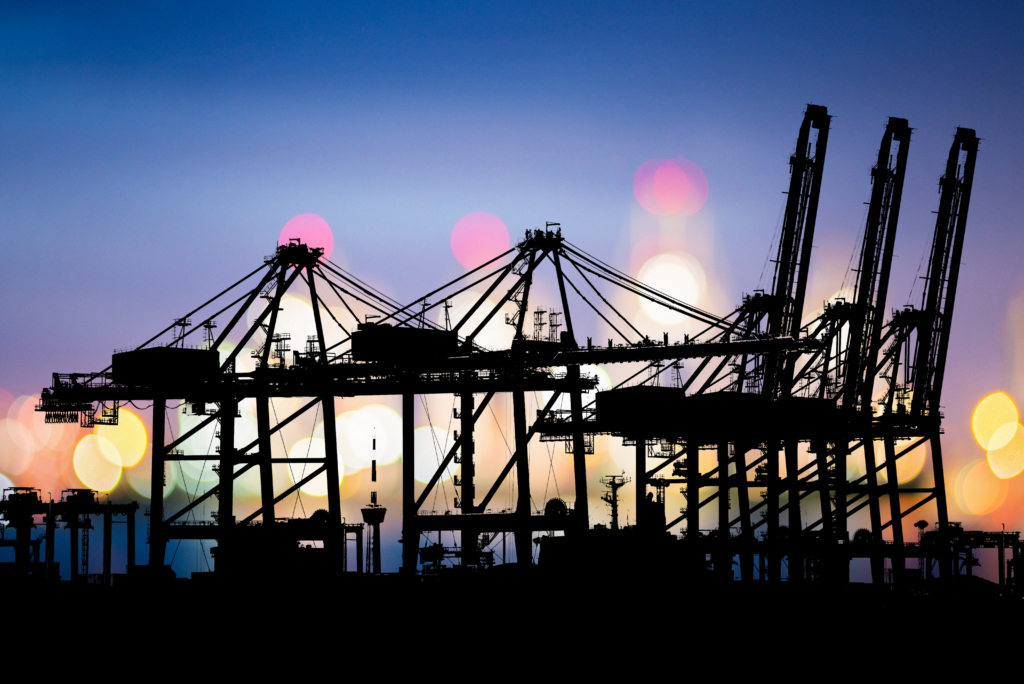Article
A Fresh perspective on driving port innovation & solutions

For a multidisciplinary Fresh team of industry experts, business strategists, creators, builders, and developers focused on port innovation, exciting things are in store for the Ports industry and our involvement in it.
But why ports? And why now?
Four key stats illustrate how vital ongoing innovation in the Ports sector is.
- “There are 15,000 miles of waterways, seaports, and other commercially navigable waters in the United States.” – NOAA
- “American ports are gateways for domestic and international trade. U.S. seaports handle over 99 percent of the country’s overseas cargo by volume and 65 percent by value.” – US EPA
- “Our nation’s ports are the lifelines of our economy. Annually, ships move $1.5 trillion in and out of U.S. ports, and ports support more than 13 million jobs.” – NOAA
- “In 2022, global container throughput reached approximately 866 million twenty-foot equivalent units (TEUs). This represented a slight increase of some four million TEUs compared with the previous year.” – Statista
For reference, 1 TEU is a container 20 feet long, 8 feet wide, and 8.6 feet high. The measurement—and the other stats listed—gives you a sense of just how integral ports are to the transportation of goods through the air, the sea, and across land. The logistical complexity of getting that volume of cargo from Point A to Point B is hard to fathom.
Recognizing that a thriving port sector is essential to the health of both the American economy and the global economy, Fresh sees an opportunity to partner with Ports in helping them adapt and grow to meet the demands of our rapidly changing world.
Increased involvement with ports across the globe presents a prime opportunity for our team to bring its end-to-end service offerings to the forefront, engaging with ports of any size to understand their unique challenges, build scalable solutions, and help decision-makers meet the future with confidence.
The innovation imperative
Ports globally are facing a variety of common challenges:
- Increased congestion, port activity, and traffic
- The call for environmentally friendly solutions
- The need for secure, safe facilities and infrastructure
- Addressing financial and resource constraints
- Building toward the future—and delivering results now
Because each port’s challenges are unique, it’s vital to approach challenges via customized solutions. Port innovation solutions must be authentic and accelerate innovation without interrupting critical operations.
Despite specific challenges being common, how the solution plays out is always unique to the port in question. Thinking proactively and strategically about solutions is vital.
- With 15,000 miles of waterways, seaports, and other commercially navigable waters in the United States alone, how can we improve marine environments—and the other pathways they’re connected to—as we streamline the global supply chain?
- With American ports acting as gateways for domestic and international trade—and international ports also playing a vital role in global logistics—how do we optimize these gateways to make them more effective and more empowered to connect with other ports and create a global impact?
- With America’s ports acting as lifelines of our economy—ships moving trillions of dollars in goods, ports collectively supporting more than 13 million jobs—how do we ensure that our nation’s lifelines stay healthy, resilient, and future-proof?
These are questions we’re excited to explore and challenges we’re eager to solve as we dive deeper into port innovation.
Five clear-cut opportunities for port innovation
#1 – Digital transformation enables modernized workflows
Applied to port innovation, digital transformation initiatives can be focused on streamlining cargo handling, optimizing physical space, and producing environmental monitoring insights that enable seamless coordination between ships, port authorities, and logistics providers. Example use cases include Port Management Systems, smart infrastructure and IoT, data analytics, and predictive maintenance.
Here are three examples of the ROI ports can expect with regard to digital transformation:
- Enhanced efficiency: Smooth, port-wide operations are a difference maker and differentiator.
- Increased transparency: Modernized systems and workflows aid ports in sharing vital data and information.
- Maximized resilience: Best-in-class digital tools are more efficient to update, improve, and scale in parallel with port development.
How we helped transform T-Mobiles legacy systems (and how that applies to ports)
Fresh worked with T-Mobile to rebuild their “Towers” system, a mapping and application system used to identify cell tower sites and streamline construction. Integrating ourselves with their stakeholders and technicians, we:
- Consolidated six dated systems into one modern application
- Rebuilt their mapping application
- Built a cloud-based digital document system
In light of our digital-first world, ports can consider similar opportunities to improve legacy systems. Digital transformation is essential, from consolidating documentation systems to creating real-time maps of port traffic, moving on-prem data to the cloud, and much more.

#2 – Mixed reality (AR and VR) increases port-wide perception
Perception is an ongoing challenge for ports, including scenarios like seeing through coaxstal fog and gaining insight into complex systems. With augmented and virtual reality, ports can get deeper levels of visibility into their processes and workflows. Example use cases include environmental monitoring, remote operations and maintenance, training, simulation, and stakeholder tours.
Three examples of how AR, VR, and MR are relevant to ports include:
- The opportunity to leverage rapidly maturing technology: AR and VR designed for real-world challenges, beyond novelty use cases, is becoming a reality
- Gaining deeper immersion into complex systems: AR and VR allow operators to understand systems at a deeper level via simulation
- Engaging decision-makers in a more powerful way: AR and VR show key decision-makers the potential for the future rather than relying on dated presentation techniques
Container Vision AR—a recent demonstration at the AAPA Annual Convention & Expo
Our goal with the Container Vision AR Solution is to integrate cutting-edge AR technologies with real-world applications in shipping container management. Beyond container vision, AR and VR present ports with an opportunity to:
- Bring more visibility into logistics workflows
- Give operators the information they need to be more successful and innovation
- Consider the infinite use cases where AR could enhance worker and operator experience into historically invisible elements of a facility
The infrastructure at ports is robust, and AR and VR present a clear-cut opportunity to solve the challenge of looking past the surface.

#3 – Robotics & automation deliver efficiency and resilience
Ports can benefit from robotic systems that can undertake tasks ranging from container handling to ship maintenance. Automation technologies can optimize cargo routing, traffic management, and more. Additional use cases include automated vehicles, robotic inspection and maintenance, and automated warehouse management.
For ports, example benefits of robotics and automation include:
- Making your workflows safer: Enable remote operation of heavy and dangerous equipment, allowing your people to stay out of harm’s way.
- The potential for scalability: Strategic innovation allows you to build, iterate, and test without wholesale implementation.
- The ability to future-proof your operations: Enhance your present-day performance and future-proof your port against evolving challenges.
A Fresh solution for the trillion-dollar-plus construction industry
We worked with United Rentals to build a platform for fleet management to change the future of work in the construction industry. Following the example set by United Rentals, ports can consider their unique challenges and explore how robotics and automation can:
- Streamline time-intensive workflows
- Augment the expertise of workers
- Decrease dull, dirty, and dangerous tasks
Robotics and automation present opportunities to support a port’s workforce in its essential role, while equipping workers to do more empowered work.

#4 – AI & Machine Learning lead to smarter workflows and logistics
To optimize operations and remain competitive, ports need technology solutions that enable real-time tracking, automated scheduling, traffic management, communication tools, and predictive analytics. Example use cases include traffic and cargo flow optimization, forecasting and data-based decision-making, automated documentation, and automated clearance.
Ports can benefit most by:
- Identifying their unique opportunity: AI & ML are rapidly evolving. Identifying ideal use cases ensures ROI.
- Optimizing their operations: Whether for scheduling, resource allocation, or environmental monitoring, AI and ML technology help achieve greater efficiency.
- Building a flexible foundation for future growth: Needs change as ports develop, and with the proper foundation, AI and ML can be adjusted in line with your evolution.
A system for seamless logistics
TruckTrax sought help rebuilding their entire resource delivery and logistics software system used to automate a construction workflow. TruckTrax had an existing tool, but needed:
- To update it to handle modern scale
- To create a more efficient tech stack
- To integrate intelligent systems that streamline decision-making
AI, ML, and other intelligent technologies can further streamline schedules and enable just-in-time intermodal movement, decreasing truck idling, and logistical roadblocks. For workflows like the example above, AI and ML can help organizations realize the next level of efficiency. For ports, the benefits of a similar solution are clear.

#5 – Biometrics can increase a port’s operational visibility
Biometrics—including facial recognition, fingerprint scanning, and iris tracking—offers a rapid and secure means of identifying individuals, simplifying access controls, and personnel tracking within port premises. Example use cases include access control, immigration and customs clearance, and worker and personnel authentication.
Biometric systems can be used at ports to:
- Enhance security: Leveraging unique biometrics attributes to reduce the risk of unauthorized access.
- Improve tracking accuracy: Monitoring the movement and location of people to improve safety protocols, manage shift patterns, and maintain work records.
- Reduce administrative overload: Ensure less reliance on paper-based documentation and manual checks, freeing up resources for other critical tasks.
A biometric digital ID project for streamlined boarding
We worked with NEC to give a collection of 26 member airlines the technology needed to streamline their boarding process by giving travelers biometrics-based digital identification.
Following the example set by NEC, ports can:
- Partner with innovation services providers to take products from conceptualization to launch
- Make the biometric tech they leverage highly usable
- Ensure biometric technology works seamlessly with their existing infrastructure
With the dozens of ways they can benefit from integrating biometric technology into their processes and workflows, ports should consider the technology and the seamless functionality within a target use case. From TWIC card readers to touchless access points, biometrics enable more seamless movement within ports.

How Fresh is enabling port innovation and how we plan to continue
Successful innovation projects often start small before growing into something more significant. Exploring biometrics could lead to the realization that more extensive digital transformation is also needed, presenting opportunities for end-to-end innovation. But the first step is meeting to discuss a given port’s challenges to understand their logistics challenges at a core level.
If you’re interested in what Fresh does and what value we might be able to offer, we can:
- Start with a conversation: Gathering team members together to explore opportunities through an agile, iterative process is a reliable way to identify problems and solutions
- Connect your team with more of our experts: A port’s historical wisdom about its strengths and areas for growth is vital; our end-to-end team can provide a consultative lens to identify paths forward
- Build a solution roadmap: Aligning your team and your stakeholders on a shared vision is vital, guided by well-established goals and a concrete plan of action
Stay tuned for upcoming events, more about our port innovation involvement, and retrospectives on our ongoing work
If you’re interested in learning more, you can find a list of upcoming events below. We’re excited to bring the expertise of port leaders and the AAPA to “The Future Of” podcast in several upcoming episodes, in addition to attending live events hosted by the AAPA domestically and internationally.
The Future of Port Innovation. A podcast episode with guests Paul Matthews (Chief Executive Officer, Port of South Louisiana), Shaun Kjar (Executive Director of Central Utah Agri-Park Inland Port), and Kristin Decas, CEO/Port Director, Port of Hueneme.
The Future of Port Policy and Finance. A podcast episode featuring Cary S. Davis, President & CEO of the American Association of Port Authorities.
Last month, members of the Fresh team attended the AAPA Annual Convention & Expo, with a panel on “How Smart Can A Port Really Get?” including Dr. Steve Elmore and technology demo at Ericsson‘s booth, one of our partners in the space. In December, we’ll also be at the AAPA LATAM Convention of Ports in Colombia.
The port innovation imperative is vital. We can’t wait to continue helping ports define the future of their industry.





